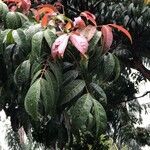A large tree. It can be 15-50 m high. The trunk can be 70-80 cm across. The bark is smooth and light brown. The bark can be cracked along its length and flake off irregularly. It has buttresses which can be high and wide. The leaves are made up of 4-5 pairs of leaflets. These are thin and rough and oblong. They can be 6-13 cm long and 2-6 cm wide or larger. The leaf tapers towards the tip. Twigs and new growth are red. The flower panicles are up to 31 cm long. The flowers are cream coloured. The fruit can be 3-5 cm long by 2-3 cm across. They have a rough surface. The seed is oval and 2-4 cm long by 1-2 cm across. Black fruit (fallen on ground). Edible fruit.

